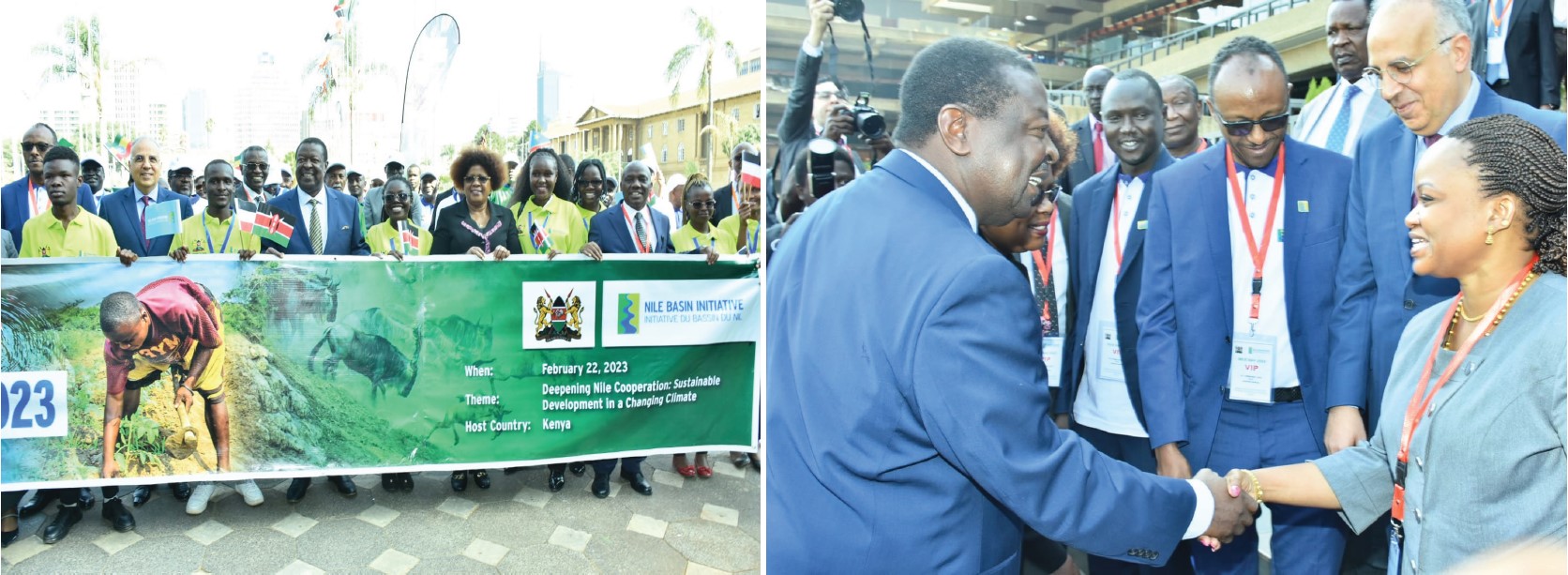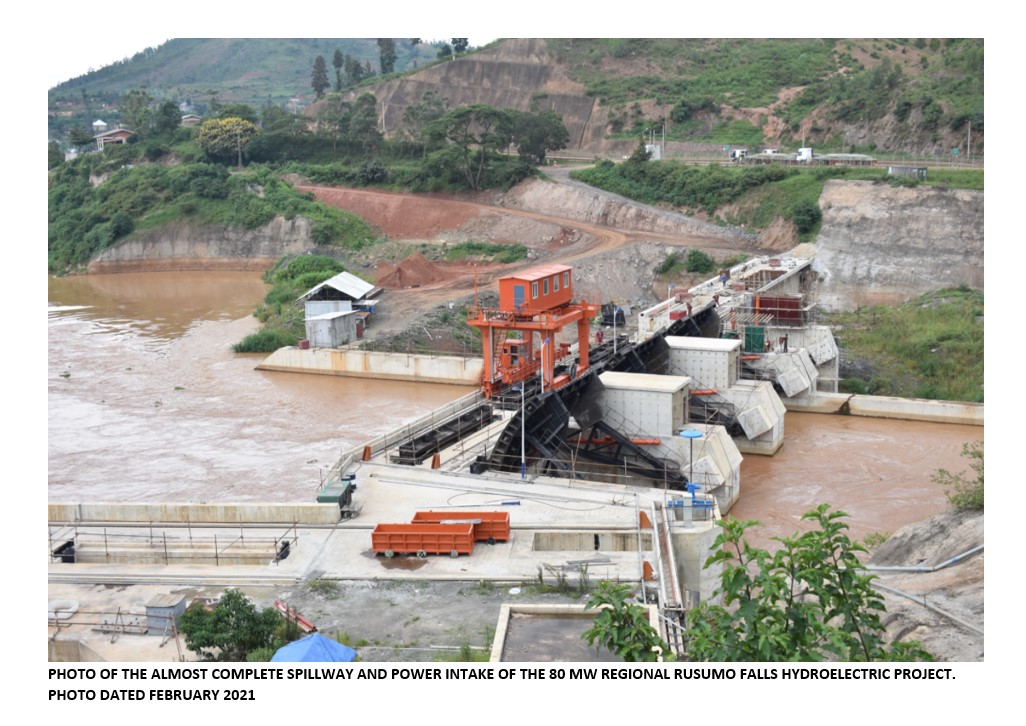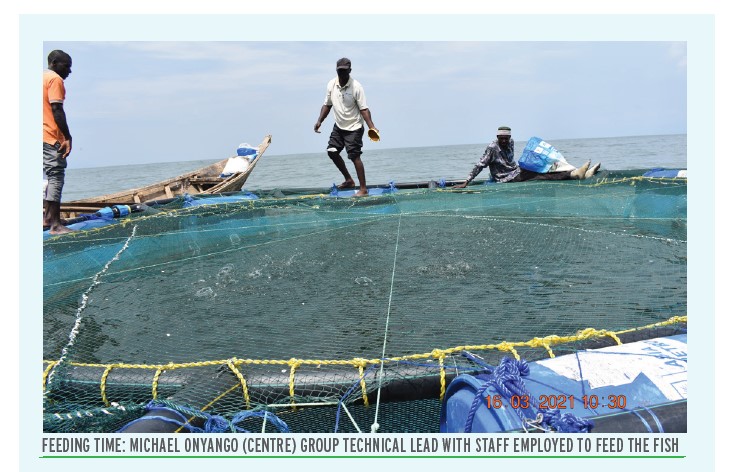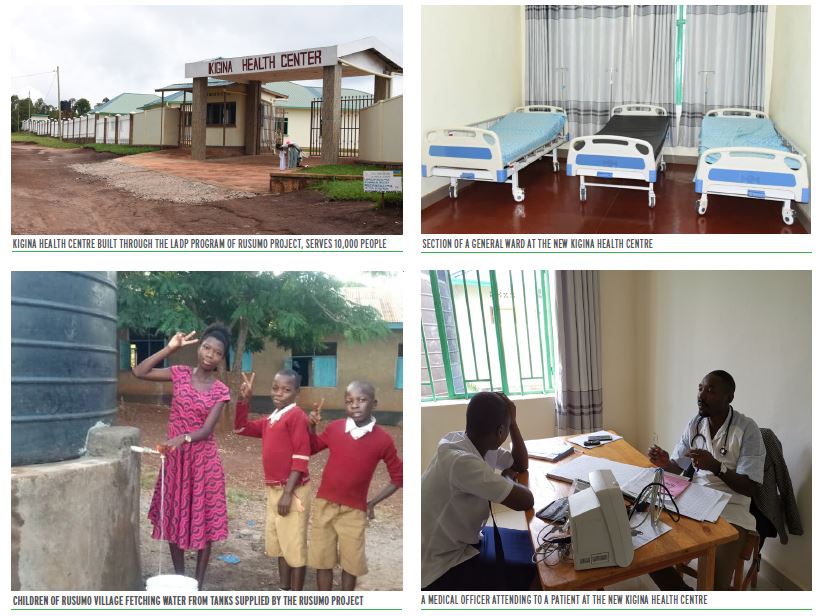NELSAP-CU within its mandate facilitates jointly agreed transformative in-country and trans boundary projects with regional significance or impacts, related to the common use of the Nile Basin water resources for the benefit of all riparian countries. The investment projects prioritized have the greatest benefit to the water, food, energy and environment sectors, improve rural livelihoods while having the least impact on the natural flow of the Nile River. NELSAP contributes to water security through evidence- catchment-based planning, enhanced storage, and more efficient (management) use of water resources, increased investment and better protection of the natural resource base, maintenance and protection of the watershed and improvement of water productivity.
ONGOING WATER RESOURCES PROJECTS
1. Multinational Lakes Edward & Albert Integrated Fisheries & Water Resources Management Project (LEAF II)
The project is jointly implemented by the D.R Congo and Uganda coordinated regionally by NELSAP. Its overall objective is to sustainably utilize the fisheries and allied natural resources of the Lakes Edward and Albert Basin through harmonized legal framework and policies. The project total budget is USD 24.2 million comprised of African Development Bank (AfDB) grant of US$ 8.785 Million to DR Congo ; AfDB loan of US$ 7.321 Million to Uganda, and Global Environment Facility (GEF) grant of US$ 8.1 Million to NELSAP-CU for the LEAF II regional activities. The Project started to be implemented from 2016 and it will end in 2021. There are significant successes already in the Lakes Edward and Albert Basin due to the implemented project activities.
Read More About LEAF II Project Here …
2. The Nile Cooperation for Results Project
The Nile Cooperation for Results (NCORE) is a Nile Basin Initiative 3 centers project implemented by three components ( 1 component per NBI Centre). The NELSAP component total budget is US$ 14.7 million funded through the Nile Basin Trust Fund (NBTF) and the Cooperation in International Waters in Africa (CIWA). The key project outputs are: 1. Feasibility, detailed design, ESIA and RAP studies for: (i)Kabuyanda Multipurpose Water Resources Development Project in Uganda with irrigation potential of 4,000 Ha;(ii)Sio-Sango Multipurpose Water Resources Development Project in Kenya with irrigation potential of 1,800 Ha;(iii)Mara Valley Water Resources Development Program in Tanzania with irrigation potential of 9000 Ha; and (iv) Ngono Valley Multipurpose Water Resources Development Project in Tanzania with irrigation potential of 13,000 Ha. 2. Information service provision to member countries on investment profiles; 3. communication and awareness creation as well as influencing policies on financing prepared transboundary investment projects 4. institutional support.
3. Angololo Water Resources Development Project Feasibility
This project is located on the trans-boundary Malaba River that is shared between Kenya and Uganda and it falls within the Sio-Malaba Malakisi (SMM) River Basin within the Lake Victoria sub basin. The project consists of a proposed 30 metre high dam with a reservoir capacity of 43.0 million cubic metres that will supply potable water to 20,000 people and irrigate 3,300 hectares (1,180 Ha in Kenya and 2,120 Ha in Uganda). The dam will generate 1.75MW hydropower. The project has a catchment area of 430 kilometres squared and is expected to benefit at least 127,300 people. The project is funded to the tune of US Dollars 1,650,000 including 1,500,000 from the African Development Bank (AfDB) NEPAD-IPPF Grant and 75,000 Country Contributions from the Governments of Kenya and Uganda.
Read More about the Angololo Project Here …
4. Akanyaru Multipurpose Water Resources Development Project Feasibility
The project is shared between Burundi and Rwanda is located on the trans-boundary Akanyaru River. Akanyaru River is part of the Kagera River basin that forms part of the Lake Victoria Basin. The proposed project is located along the transboundary Akanyaru River which defines the border between the Southern Province of Rwanda and Burundi’s Ngozi Province. The project comprises a 52m high dam with storage capacity of 333 million cubic metres that will supply water to 614,200 people and irrigate 12,474 ha directly benefitting 24,948 farmers. It will also generate 14.5 MW hydropower which will power 141,111 homes and serve 846,000 people. The project also includes restoration of degraded watersheds upstream of the dam. NELSAP is in advanced discussions with the African Development Bank (AfDB) NEPAD-IPPF and Africa Water facility (AWF) to support this Feasibility Phase. The Project will cost USD 2,150,000 for full Feasibility Detailed Designs and Independent ESIA and RAP studies. Full investment cost will be USD 191 million for investment, operation and maintenance for 25 years with corresponding investment cost of USD 7,500 per ha
Read More About the Akanyaru Project Here ….
5. Nyimur/Limur Multipurpose Water Resources Project Studies
The project is funded by the African Development Bank through the African Water Facility of the (AWF/AfDB) to a tune of Euro 1.975 Million. The project is located in Lamwo District in Uganda and in Magwi County of the Eastern Equatorial State in South Sudan, and consists of a 5,105Ha community based irrigation scheme, a water reservoir, and a water and soil conservation components and a mini hydropower plant.
6. Support to Trans boundary Water Cooperation in the Nile River Basin (EU-BMZ Wetlands Project)
The objective of the project is to strengthen the knowledge base on wetlands of transboundary importance in the Nile Basin to support basin-wide conservation, management, planning and restoration efforts; Raise awareness and undertake advocacy efforts on the important role of wetlands and their ecosystem functions for the basin’s development; Develop and promote a basin-wide approach for the sustainable and cooperative management of wetlands taking into account the full range of wetland uses; and to Strengthen national policies and institutional capacities for the effective management of wetlands with basin-wide importance. The Project is implemented in the NEL countries and is supported by the German Government and jointly implemented by GIZ.
7. The Regional Hydromet Project
NELSAP is coordinating establishment of hydrological monitoring network of stations in Burundi, D.R Congo, Kenya, Rwanda, Tanzania and Uganda to provide real time data and more reliable information to improve water resources planning and management both at national and regional levels. This will enable flood and drought disaster preparedness, monitoring of surface water quality and sediment transport, coordinated management of water storage dams, navigation and improved adaptation to climate change. The NELSAP component is part of the Nile Basin Regional Hydromet project, which is a basin-wide Euros 5.5 million EU-BMZ funded project that will install a total of 80 hydrological stations across the Nile River basin. The project is being implemented by the three NBI centers and NELSAP is responsible for the NEL region.
8. Technical Assistance for Capacity Building for River Basin Planning Project
The project is funded by the Agence Française de Développement (AFD) to a tune of Euro 1Million (800,000 to NELSAP and 200,000 to Nile Secretariat) for capacity development in order to strengthen the institutional framework and capacity of the Nile Equatorial Lakes Subsidiary Action Program (NELSAP) to manage and develop the region’s water resources, within the context of the Nile River Basin. The Technical Assistance (TA) focuses on four areas: (i) strengthening strategic planning and organizational development; (ii) strengthening the NELSAP Knowledge Systems (iii) strengthening investment finance mobilisation; and (iv) strengthening the regulation of dam safety. The results of the project implementation are (i) development of the five years strategic plan (2017- 2022) that will guide the business operations of NELSAP program, (ii) procurement of knowledge management tools/equipment, (iii) training 36 people on Dam Safety Operations and Risk Management as well as (iv) Dam Safety Training manuals available for member countries.
ReadMore About Technical Assistance for Capacity Building for River Basin Planning Here ….
COMPLETED WATER RESOURCES PROJECTS
1. Lakes Edward and Albert Fisheries Project (LEAF I)
LEAF I was among the NBI projects that the AfDB committed to support in the International Consortium on the Cooperation on the Nile (ICCONI)1 in 2001. The project was implemented over a 3 years period (2005-2008) with a funding of USD 2.3 million. The project was identified under the NELSAP and it was shared between the Democratic Republic of Congo (DRC) and Republic of Uganda. This phase was designed to generate replicable experiences in the management of fisheries resources in a trans boundary context; to avail to DRC and Uganda a sustainable investment and management plans for the joint use of the water and fisheries resources of Lakes Edward and Albert Basin and identify the major socio-economic problems.
2. Regional Agricultural Trade and Productivity Project (RATP)
The project was financed by the World Bank up to a tune of USD7.0 Million and implemented over a four (4) years period (2009 -2012). It was a priority project to enhance food security and promote pro-poor growth in the Nile Basin. The Project delivered the following studies: (i) developed the Nile Basin Agricultural Model, (ii) assessed the irrigation potential in seven (7) Nile Equatorial Lakes Countries of (Burundi, DRC, Rwanda, Kenya, Sudan, Uganda, Tanzania), (iii) promoted the best practices on water harvesting and irrigation practices, (iv) cross border agricultural trade studies focusing on Trans-boundary Grain/ Pulses Trade, Livestock Trade in the Nile Basin Region”, (v) virtual water/water footprint analysis, documentation and awareness creation as well as (vi) definition of the NBI agricultural role, based on study of River Basin Organization (RBO) lessons, and national and regional consultations.
3. Nile Equatorial Lakes Water Resources Development Project
Over a thirty four (34) months period (2010-2012). The project supported the scaling of the NELSAP strategy with a specific development objective to identify and advance the preparation of a strategic portfolio of ‘bankable’ Water Resources projects that demonstrate benefits of cooperation to each NEL Country within a broader coordinated water-related investment strategy for the region. The project identified investment projects worth USD 2,752 Billion following the delivery of the following key studies: (1) project preparatory studies to enable the formulation of cooperative investment projects in five NEL sub basins; i.e. Gucha-Migori and Yala river basins in Kenya; Lake Kyoga basin in Uganda; Aswa basin between South Sudan and Uganda; and Lake Victoria basin in Tanzania (2) a regional analysis (multi sector investment opportunities analysis); and (3) regional facilitation and coordination.
4. NELSAP Trans-boundary River Basin Management Program
The project was funded by the Governments of Sweden and Norway to the tune of USD 6.484 Million. The project was implemented over eight(8) year (2006-2014) period and supported the pre-investment bridging phase program for the three River Basin Management (RBM) projects of Mara basin (Kenya-Tanzania), Kagera basin (Tanzania, Rwanda, Uganda &Burundi) and Sio-Malaba-Malakisi Basin ( Uganda-Kenya). The Project Development Objective were to establish a sustainable framework for the joint management of the water resources of the three sub basins; in order to prepare for sustainable development oriented investments to improve the living conditions of the people and to protect the environment. The objective for the bridging phase was to strengthen trans-boundary water resources planning and development. The specific grant objectives were: (i) to conclude the establishment of the River Basin institutions within the context of a framework that includes both the Lake Victoria Basin Commission (LVBC) and NBI and (ii) to supervise preparation of regional multi-purpose water infrastructure projects.
5. Integrated Management of Trans-boundary Water Resources of Lakes
Cyohoha, Rweru and Akanyaru Marshland Project
The Integrated Management of Trans-boundary Water Resources of Lakes Cyohoha and Rweru and Akanyaru Marshland project (Known and abbreviated in French as GIRET Project) was financed by the African Development Bank through African Water Facility to a tune of Euro 770,000. The preparatory study was implemented over three (3) years’ period (2010 - 2012). The project delivered the following key studies: i) Integrated Management and Development Plans (IMDP) for the three water resources and Investments Profiles (IP); ii) a Diagnostic Analysis with an environmental screening of the water-resources; iii) constructed three hydro-meteorological stations enabling collection and sharing of the shared water resources data; iv) Trained forty (40) local key actors in fishery management and policy, environment and IWRM principles and law implementation.
PIPELINE OF NEW KEY WATER RESOURCES PROJECTS
(i) The Nile Equatorial Lakes Investment Program (NELIP)
In order to ensure country driven multi-sector and basin-wide approach to multipurpose infrastructure projects including fisheries production, irrigation development/ expansion, hydropower production, interconnection of power grids and watershed management planning and implementation in the Nile River basin, NBI/NELSAP is coordinating Nile Basin member countries to design, structure and package in-country and trans-boundary priority investment projects under the Nile Equatorial Lakes Investment Program (NELIP). NELIP will champion investments from studies already undertaken by NELSAP.
Read More About the NELIP Here …
Summary of Other Pipeline Projects
(ii) Trans-boundary Diagnostic Analyses (TDA) /Feasibilities studies and implementation of the Jebel-Awelia-Renk-Malakal Integrated Water Resources and Fisheries Management project (shared between South Sudan and Sudan)
(iii) Feasibility Studies Detailed Designs, ESIA and RAP studies and implementation of the Kocholio Amoni-Amagoro Irrigation and Food Crop Value Chain Development Project in Kenya.
(iv) Ruviryonza Multipurpose Water Resources Management and Development Project in Burundi.
(v) Angorora Multi-Purpose Water Resources trans boundary project (Kenya & Uganda)
(vi) Akanyaru Multi-Purpose Water Resources trans boundary Project (Rwanda& Burundi)
(vii) Implementation of the Nyimur Multipurpose Water Resources Management and Development Project shared between South Sudan and Uganda.
FACTSHEETS - NELSAP WATER RESOURCES MANAGEMENT AND DEVELOPMENT PROJECTS
- Lakes Edward and Albert Integrated Fisheries and Water Resources Management Project (DRC/Uganda)
- Angololo Water Resources Development Project (Kenya and Uganda)
- Akanyaru Multipurpose Water Resources Development project (Burundi / Rwanda)
- The Nile Equatorial Lakes Investment Project, NELIP (NEL Countries)
- Sio-Malaba-Malakisi River Basin Management Project (Kenya/Uganda)
- Mara River Basin Management Project (Kenya/Tanzania)
- Kagera River Basin Management Project (Uganda, Rwanda, Burundi, Tanzania)
- Nyimur Multipurpose Water Project (South-Sudan and Uganda)
- Bugesera Watershed Management Project (Rwanda/Burundi)










































































